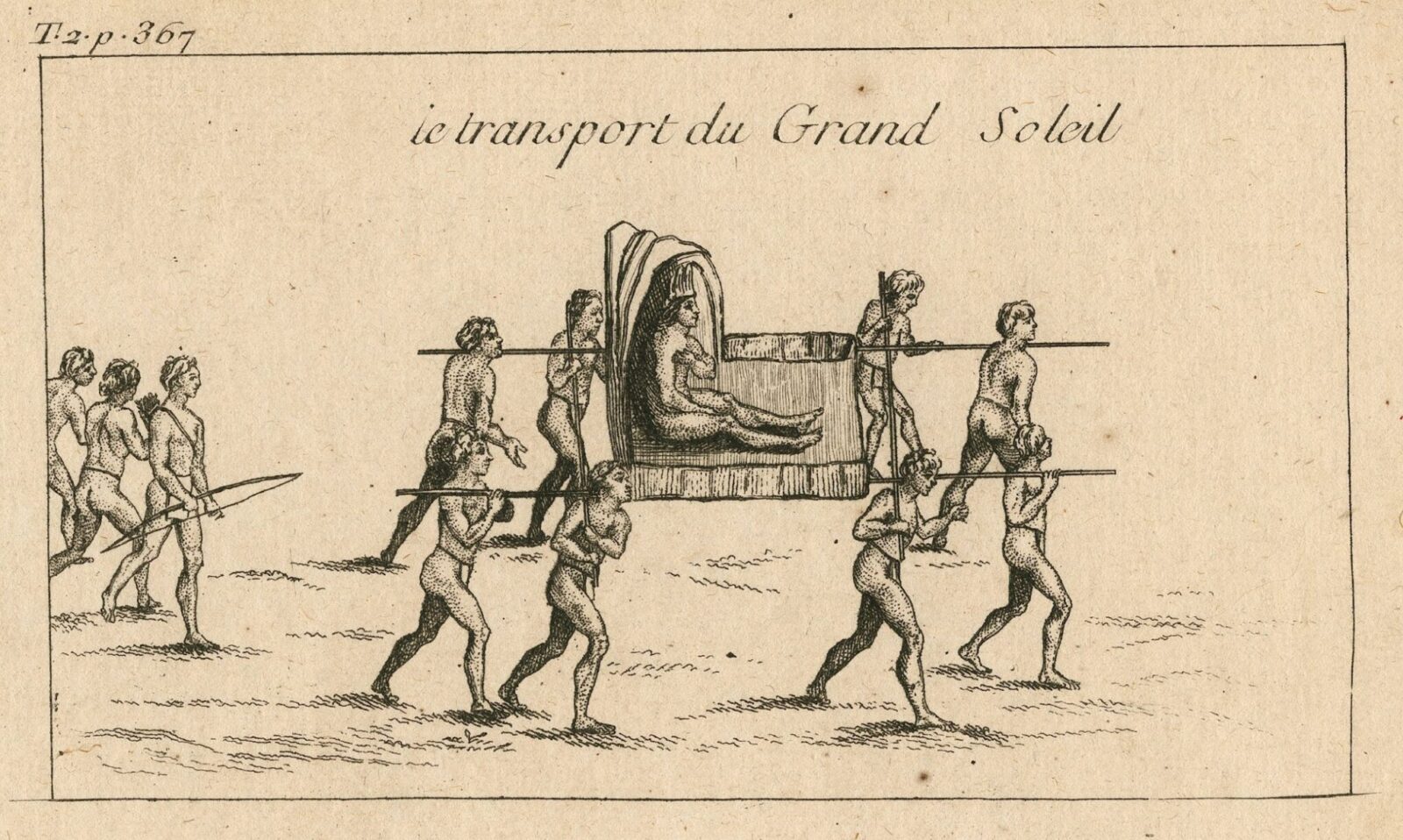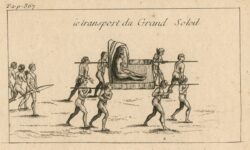Natchez Indians
Both French and British colonists sought alliances with the Natchez Indians, an American Indian group with settlements along the Lower Mississippi River.
This entry is 6th Grade level View Full Entry

The Historic New Orleans Collection
Le transport du Grand Soleil by Antoine Simone Le Page du Pratz.
The Natchez were one of several important American Indian groups with settlements along the Lower Mississippi River in the seventeenth and eighteenth centuries, when both Britain and France expanded colonization efforts in North America.
How are the Natchez linked to earlier prehistoric cultures?
The Natchez are known from extensive records made by colonial administrators and by archaeological evidence in present-day Adams County, Mississippi. Modern archaeologists and historians rely on French descriptions of Natchez ceremonial events to help understand the precolonial mound sites across the southeast. The group’s ceramics, building construction, and ceremonial mound centers link them to the prehistoric Plaquemine culture.
What are some characteristics of Natchez villages and the Natchez way of life?
French explorer René-Robert Cavelier, sieur de La Salle, led an expedition into the Lower Mississippi Valley in the 1680s. His writings reveal that significant changes had occurred since de Soto’s expedition passed through nearly one hundred and fifty years earlier. Populous Native chiefdoms had been replaced by smaller societies that came to include the historic tribal groups along the Mississippi, including the Natchez, Taensas, Tunicas, Houmas, and Quapaws.
The Natchez were organized into a loose confederation of Native settlements that French observers recorded as Grand Village, Flour, Tiou, Grigra, White Apple, and Jenzenaque. French maps and narrative descriptions of Grand Village describe a cluster of six mounds on the west side of a small tributary of the Mississippi. Two mounds served as platforms for buildings that the French referred to as “temples.” These temples served as tombs for the chiefs and other high-ranking tribal officials. In 1704 and 1725 the French observed elaborate funeral ceremonies for an unnamed female chief and a male chief named Tattooed Serpent. To the horror of European witnesses, the funeral events included human sacrifice. In Natchez culture victims were intended to accompany dead chiefs into the afterworld.
Like many other Indigenous groups in the southeast, Natchez society was based on female kinship. Women controlled family farms, and men married into female lineages. The principal crops were corn, beans, squash, wild and semi-domesticated grains, tubers, fruits, and nuts. Armed with bows and arrows and guns acquired through trade with Europeans, hunters killed deer, bear, and smaller game. Fish were also abundant in the Mississippi River and the numerous lakes and streams throughout the region.
Did the European powers seek alliances with the Natchez? Why did the Natchez seek alliances with different European powers?
Both the French and British aggressively sought alliances with the Natchez as the two colonial powers battled for control of the Mississippi Valley. For their part, the Natchez bargained shrewdly with European agents to gain access to guns, ammunition, blankets, metal tools and utensils, and many other materials they could not produce themselves. Throughout the colonial period, deerskin was the principal American Indian currency for French and British trade goods. Despite the appearance of unity, Natchez leadership was divided up among the chiefs controlling each settlement. The Jenzenaque, Grigra, and White Apple settlements developed trading relationships with the British, while the Tiou and Flour settlements partnered with the French.
Those living in Natchez settlements allied with the British participated in the Native slave trade. These Natchez Indians would capture people from smaller, more vulnerable Native groups and sell them to the British in exchange for trade goods. The British in turn sold Native captives to British-run plantations in the Caribbean and elsewhere.
What caused the 1729 Natchez Revolt?
After 1700 French-Canadian fur traders and missionaries made frequent stops at the Natchez river landing (near present-day Natchez, Mississippi). In 1713 the Natchez allowed the French to establish a trading post in the area, and in 1716 France established the Natchez colony—a French settlement amid Natchez lands—and built Fort Rosalie on the bluff overlooking the river landing. The continued presence of French soldiers at the fort and the influx of French settlers encouraged by John Law’s Company of the West led to disputes with the Natchez. These tensions, combined with a French officer’s attempt to seize Natchez land, resulted in the 1729 revolt.
What were the effects of the 1729 Natchez Revolt on the Natchez Indians?
The Natchez Revolt—in which Natchez warriors retaliated against the French by killing more than 200 French men, women, and children and taking enslaved Africans as well as French women and children hostage—took place in November 1729. Some enslaved Africans joined the Natchez in revolt while others resisted alongside the French. The French and their Native allies, including the Choctaws and the Tunicas, struck back hard. The war ultimately led the Natchez to abandon their homeland. Some Natchez fled to a site near present-day Sicily Island in Catahoula Parish. The French captured part of this group and sold some of the captured Natchez into slavery in the French Caribbean colony of Saint-Domingue (now Haiti). The remaining Natchez migrated east to seek safety with pro-British tribes, first the Chickasaws, later the Creeks and Cherokees. Some Natchez descendants remained in scattered settlements in the southeast while a small group enslaved by the French in Saint-Domingue may also have descendants in present-day Haiti.
